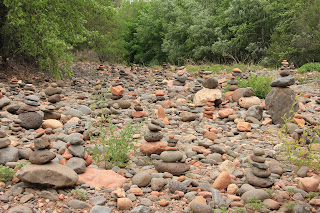Cairn is a man-made pile (or stack) of stones. See mine below =)
In modern times, cairns are often erected as landmarks, a use they have had since ancient times. Since prehistory, they have also been built as sepulchral monuments, or used for defensive, hunting, ceremonial, astronomical and other purposes.
Today, cairns are built for many purposes. The most common use in North America and Northern Europe is to mark mountain bike and hiking trails and other cross-country trail blazing, especially in mountain regions at or above the tree line.
Most trail cairns are small, a foot or less in height, but may be built taller so as to protrude through a layer of snow. Hikers passing by often add a stone, as a small bit of maintenance to counteract the erosive effects of severe weather.
North American trail marks are sometimes called "ducks" or "duckies", because they sometimes have a "beak" pointing in the direction of the route. The expression "two rocks do not make a duck" reminds hikers that just one rock resting upon another could be the result of accident or nature rather than intentional trail marking.
Placed at regular intervals, a series of cairns can be used to indicate a path across stony or barren terrain, even across glaciers. Such cairns are often placed at junctions or in places where the trail direction is not obvious, and may also be used to indicate an obscured danger, such as a sudden drop, or a noteworthy point such as the summit of a mountain.
In the mythology of ancient Greece, cairns were associated with Hermes, the god of overland travel. According to one legend, Hermes was put on trial by Hera for slaying her favorite servant, the monster Argus. All of the other gods acted as a jury, and as a way of declaring their verdict they were given pebbles, and told to throw them at whichever person they deemed to be in the right, Hermes or Hera. Hermes argued so skillfully that he ended up buried under a heap of pebbles, and this was the first cairn.
In South Korea cairns are quite prevalent, often found along roadsides and trails, up on mountain peaks, and adjacent to Buddhist temples. Hikers frequently add stones to existing cairns trying to get just one more on top of the pile, to bring good luck. This tradition has its roots in the worship of San-shin, or Mountain Spirit, so often still revered in Korean culture.
Modern cairns may also be erected for historical or memorial commemoration or simply for decorative or artistic reasons. Cairns have also been suggested as a three dimesional symbol of atheism, both because cairns have been around since long before the start of the monotheisms, and because a three stone carin replicates the outline of an atheist A.
I love cairns!










No comments:
Post a Comment